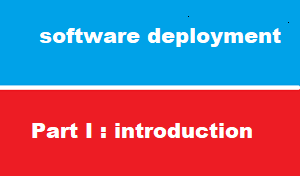introduction
welcome to first article of software deployment from course SCCM
this article we will get an overview about SCCM software deployment and how it help system administrator to easily manage all software in IT environment
challenge in software deployment
most system administrator face challenge to install and manage software through network , specially with
- different operating system vendor like MS , and linux
- different operating system version
- different operating system service pack
- different software version
- some client computer have limited hardware to install software
- software update process
the solution come with SCCM software deployment which can manage and control all of these aspects above
SCCM software deployment
Deploy packages is one of Software Library three features in SCCM which :
- OSD Operating System Deployment
- software deployment : packages and application
- SUP : software update Service , which sometimes called WSUS Windows Server Update Services
Administrators can create custom installations of applications and configurations which can be repeated across numerous workstations with SCCM.
SCCM is effective in desktop management and brings down administrative costs.
deploy software using GPO vs SCCM
most system administrators prefer to deploy software with active directory GPO [Group Policy Object ] : which is OLD technique but still used in current days especially for administrator who don’t like to bother them self with new technology
here some brief comparison between both :
First,
- Both enable user to install application with need administrative right
second
- support extension : GPO support .msi or .zap à
- while SCCM support also ,exe .msi , or even cmd power shell that modify registry
third
- Deployment type : GPO support published or assigned
- Published : [which enabled only for users GPO ] user can install software frm control paned
- Assigned : [which enabled for both user and computer configuration GPO ] à once user open extension file that related to application [like .docs or xls ]à then application auto installed to his computer
Fourth
- GPO is based on OU level
- While SCCM could be based on user or computer collection that match specific criteria
Fifth
- GPO applied when user login direct
- While SCCM could be applied on schedule
Applications vs. Packages
Here in networks pioneers, we found it’s better to start with a quick comparison between applications and packages.
First,
applications are primarily designed for user deployments, while packages are primarily designed for device deployments.
You can still use packages for user deployments and applications for device deployments
BUT ,,,
the settings in each type are just more geared for one versus the other.
Second
applications can utilize the new approval request feature. This is the feature that allows the administrator to deploy applications to a wider user base, while still maintaining license control.
.
Third,
applications provide a much greater level of detail when looking at the application’s deployment status.
It pulls up error codes, and also has more categories of statuses.
Fourth,
the application feature can deploy apps to devices that are in the
- Apple App Store (for iOS devices),
- Google Play store (Android devices)
- or the Windows Store (for Windows Phone ).
This allows administrators to provide these apps in a managed format.

